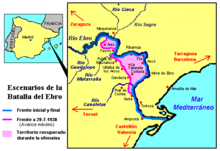Battle of the Ebro
Spanish Civil War (1936-1939)
Gijón - Oviedo - Alcázar of Toledo - Mérida - Badajoz - Guipúzcoa - Mallorca - Sierra Guadalupe - Talavera de la Reina - Madrid - Road to Coruña - Málaga - Jarama - Guadalajara - War in the north ( Durango , Guernica , Santander ) - Brunete - Belchite - Teruel - Cabo de Palos - Aragon - Ebro - Catalonia
The Battle of the Ebro from July 25 to November 16, 1938 was the last major offensive of the republican government against the Francoist troops, which were already superior at the time, and during the Spanish Civil War . The battle was fought with extreme severity on both sides and resembled the battles in World War I , which were characterized by bloody frontal attacks on the opposing positions.
prehistory
By 1938 the situation for the Second Spanish Republic was hopeless. Since the lost battle of Teruel , it finally seemed militarily on the defensive. With the advance of the Francoist troops to the Mediterranean at Vinaròs , Catalonia was cut off from the rest of the territory in central and eastern Spain under the control of the republican government.
In this situation, the Spanish Prime Minister Juan Negrín approved a plan by Vicente Rojo Lluch to attack the main force of Franco's troops advancing on Valencia. The aim of the offensive was to take the military pressure off Valencia and show the European governments that the Republican government was still an alternative to Franco.
battle
The Republican forces were under the command of Colonel Juan Modesto . The Battle of the Ebro began on July 25, 1938 with initially successful attacks by the Republicans across the Ebro . The superior air force of Franco's troops, significantly supported by the German Condor Legion , which u. a. was in La Sénia , but soon brought the crossing of the river between the towns of Mequinensa and Amposta to a standstill, and the numerically superior and better-equipped nationalist troops managed to repel the Republicans. The Republican army had to advance over open terrain during its offensive and thus exposed itself defenseless to the air and artillery superiority of the enemy side. The regions of Matarraña , Ribera d'Ebre , Baix Ebre and Terra Alta saw the greatest concentration of warring forces in Catalonia's history, with tens of thousands dead.
The fiercest fighting at the places were Miravet , Corbera d'Ebre , Gandesa , de El Pinell Brai , La Pobla de Massaluca , Ascó , Riba-roja d'Ebre , Benifallet , La Fatarella , Flix (Tarragona) and Mora d'Ebre out .
The numerical superiority of Franco's troops finally brought the decision and so the battle ended on November 16, 1938 with a victory for Franco's armed forces.
Consequences

The inability of the Republican generals to end the battle they had already lost, and the resulting massive loss of people and material, resulted in the Republican army ultimately lacking the resources to continue the war. Subsequently, Franco's troops began the Catalonia offensive on December 23, 1938 . This was made easier by the fact that, after the losses on the Ebro, the Republicans hardly had any modern weapons to fend off their opponents.
Individual evidence
- ^ Military History Research Office , 2004: Compilation of documents on the person of Werner Mölders on the occasion of the question of the use of the traditional name Mölders
Web links
literature
- Ranzato Gabriele: The Spanish Civil War. Arris Books, Moreton-in-Marsh, Gloucestershire, 2005, ISBN 1-8443-7049-6 .

